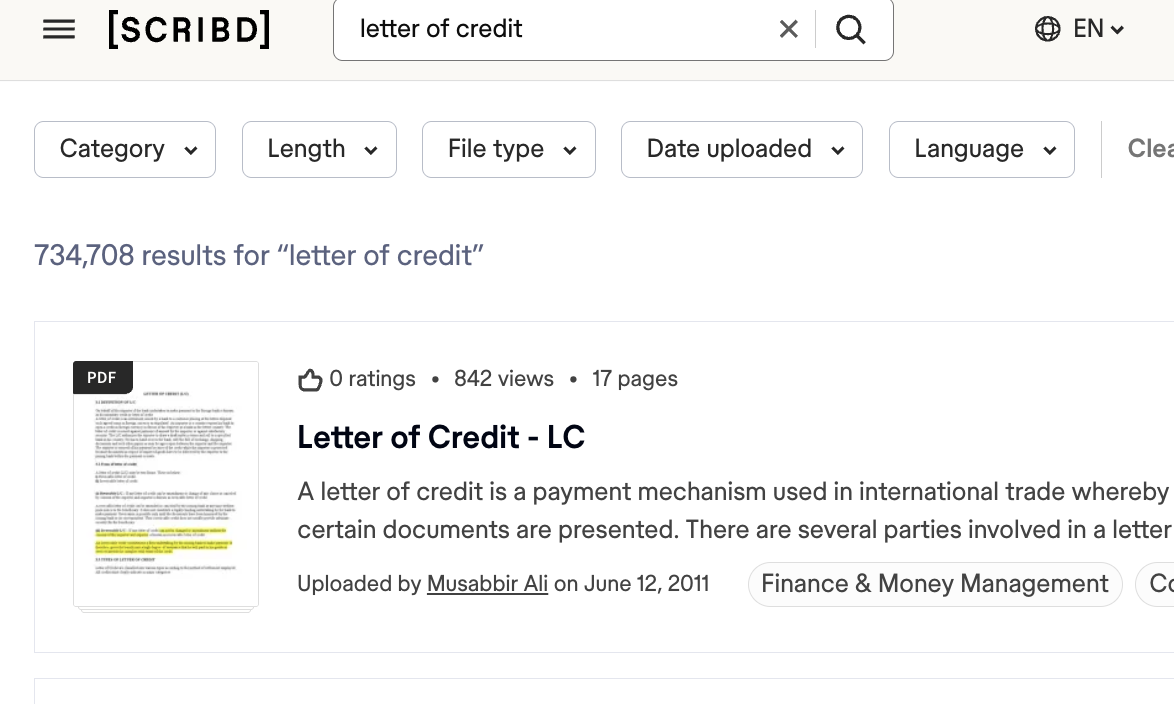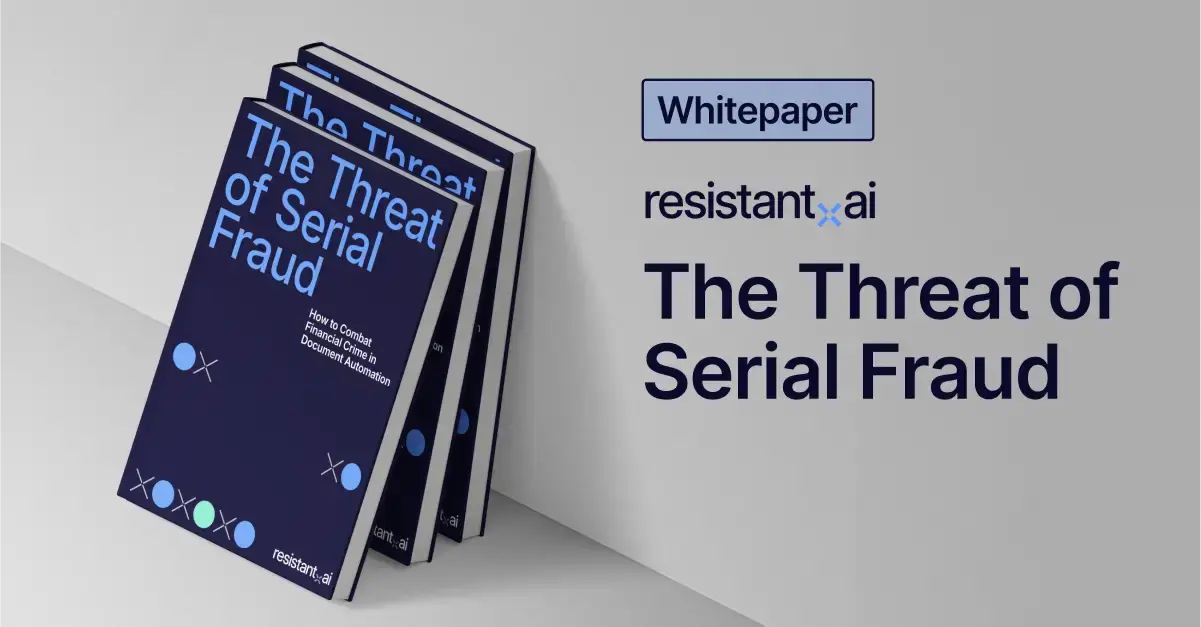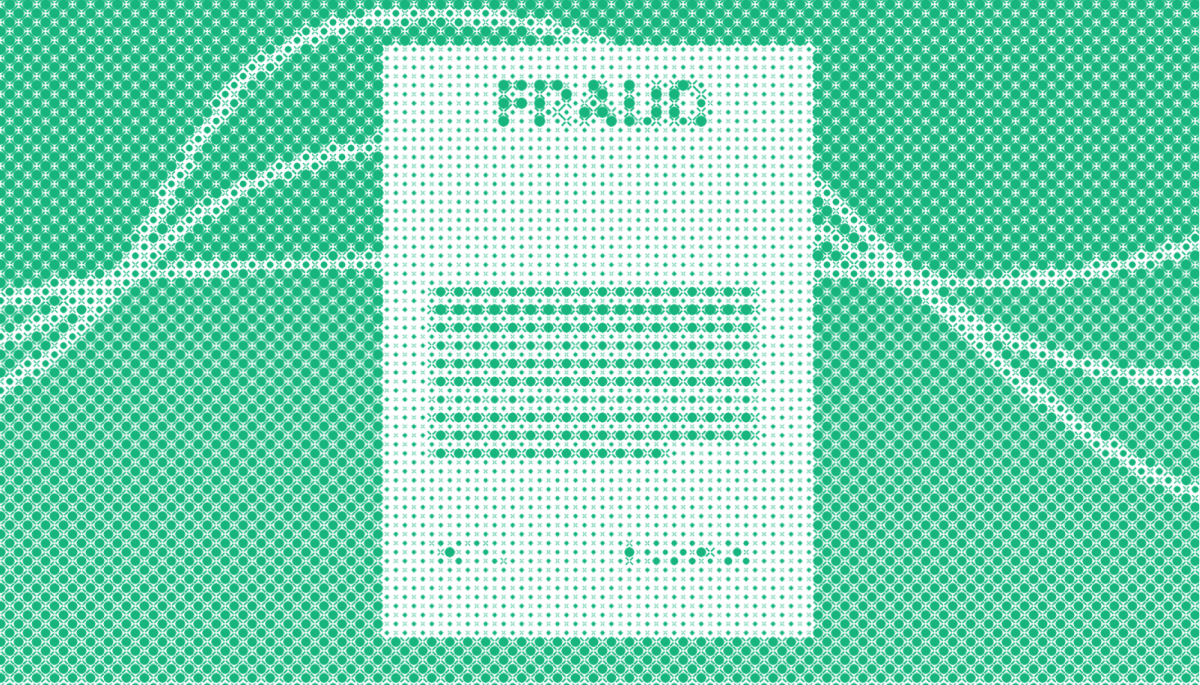How to spot fake letters of credit



Fake letters of credit are a global problem. Whether you’re in Mumbai, or Hong Kong, or the United States, these fraudulent instruments have fueled inflated shipments, unpaid cargo, and fraudulent collateral protection insurance for decades.
Now we’re in 2025 and letters of credit are still central to international commerce. They act as a financial guarantee that a seller will be paid once contractual terms are met.
New technology has caused the fake letters of credit problem to escalate. Editable templates and generative AI tools allow criminals to clone authentic-looking LCs with ease. A convincing fake can help fraudsters secure goods, financing, or trade insurance they have no intention of honoring.
Read on to learn what letters of credit are, how they’re being forged, how to spot a fake, and how AI-powered tools can help.
Check out our "how to spot fake documents" blog to learn about more common document forgeries.
What is a letter of credit?
A letter of credit (LC) is a financial instrument issued by a bank on behalf of a buyer that serves three main purposes:
- Payment guarantee. Ensures the seller will be paid once they present the required documents.
- Risk reduction. Protects both parties in international trade by shifting payment risk from the buyer to the bank.
- Trade facilitation. Provides a trusted mechanism for moving goods and money across borders under agreed conditions.
Its main purpose is as a safety net in international trade, ensuring both parties can trust the transaction even if they don’t know each other directly.
If you’d like to learn more about documents in the trade finance process, visit our bill of lading blog.
Despite some variations depending on the issuing bank, country, or type (revocable, irrevocable, confirmed, standby), most LCs follow a consistent format because they’re governed by international standards like the Uniform Customs and Practice for Documentary Credits (UCP 600).
You’ll almost always see the same core elements:
- Issuing bank name and reference number. Identifies the financial institution guaranteeing payment and assigns a unique tracking code.
- Applicant (buyer) details. Lists the importer’s legal name, address, and sometimes their account number.
- Beneficiary (seller) details. Provides the exporter’s business name, address, and banking information.
- Credit amount and currency. Specifies the maximum sum available under the LC, denominated in a specific currency.
- Expiry date and place of presentation. Defines when and where the LC can be drawn upon.
- Documents required for payment. Outlines mandatory proofs such as bills of lading, commercial invoices, insurance certificates, or inspection reports.
- Terms and conditions. Sets out shipping deadlines, Incoterms, or other performance requirements.
- Authentication codes and SWIFT details. Ensures secure communication between banks and verifies the LC’s origin.
- Authorized signatures and seals. Confirms the issuing bank’s legitimacy.
- Additional information. May include governing law, jurisdiction for disputes, or special clauses.
Most modern letters of credit are transmitted through the SWIFT network, specifically as MT700 series messages. This secure banking system authenticates the LC with unique reference numbers, BIC (bank identifier) codes, and message formatting that can’t be replicated by ordinary word processors. For verification purposes, the SWIFT details are often more important than visual features like logos or seals.
Letters of credit function as “proof of payment security” in trade finance, much like a mortgage pre-approval or bank guarantee serves as proof of creditworthiness in personal finance. They demonstrate that a trusted bank stands behind the buyer’s obligation, making the transaction safer and the seller’s payment virtually assured.


Why are letters of credit important?
Letters of credit help businesses navigate the risks of doing business across borders. By guaranteeing payment, they reduce uncertainty and unlock commerce between counterparties who may never meet in person.
Beyond that, a letter of credit serves as evidence of financial backing, trade terms, and contractual compliance. Its significance for document verification cuts across specific industries:
- International trade. Ensures exporters get paid once they present the correct shipping and customs documents.
- Banking and finance. Supports lending decisions and secures trade finance arrangements where repayment risk is high.
- Insurance. Allows underwriters to confirm that a transaction is financially backed by a bank before issuing trade credit or cargo coverage.
- Shipping and logistics. Confirms that cargo will be released only when the LC’s conditions are satisfied.
- Government export agencies. Provides assurance that goods leaving a country meet regulatory and sanction requirements.
Letters of credit remain trusted because they carry the weight of a financial institution’s guarantee, making them one of the most reliable documents in international transactions.
If you’d like to know how fraudsters are creating all these fake letters of credit, check out our “Types of fraud” blog to learn more about their tactics.
Threat intel: Template data about fake letters of credit
Our Threat Intelligence Unit collects data about template farms which make and distribute fake document templates for fraudulent purposes.
During our research we haven't yet cataloged many letters of credit documents, however, they are still very prevalent online. A simple search on Scribd.com (a well known template hub) reveals 700,000+ results for this document, revealing a high demand for online templates.

Search results for "letter of credit" on Scribd.
Threat level: Given the nature of the document, these templates are mostly like being used for legitimate research or fraud.
Legal teams and shipping companies do use online letters of credit templates for training, meaning the act of downloading them isn't inherently fraudulent.
When it comes to document verification, legitimate letters of credit would be assembled internally by the bank — meaning documents based off online templates should be immediately escalated for further review.
5 Signs of a forged or fake letter of credit
Missing a fake letter of credit can mean cargo is released without payment, loans are issued against worthless guarantees, or sanctioned trade passes through uncontrolled.
Fraudsters know these documents often move quickly through compliance workflows, so they exploit speed and volume to sneak in fakes.
Detecting them manually requires sharp attention to detail and is better done by document fraud detection software.
That said, below are the most common red flags of fake letters of credit if you’re still trying to spot fraud manually.
1. Inconsistent formatting
Authentic LCs follow strict banking templates and SWIFT standards. Fakes often present visual miscues:
- Non-standard section order. Real LCs follow a fixed sequence (issuing bank → applicant → beneficiary → amount → expiry → conditions).
- Incorrect date formats. SWIFT LCs display dates as YYMMDD (e.g., 250930). A format like “09/30/25” is a red flag.
- SWIFT formatting errors. Fake LCs may display invalid BIC codes, missing reference numbers, or structures that don’t match standard MT700 messages.
- Missing continuation marks. While the SWIFT MT700 message (the standard for issuing an LC) is usually a single, structured transmission, many LCs in practice span multiple pages when exported into PDF or print format. Multi-page LCs usually include page counts (“Page 1 of 3”). Absence of this structure can indicate a forged or manually assembled document.
- Improper field labels. Genuine LCs use precise SWIFT terms like “Beneficiary” or “Available With… By.” Fakes may use casual substitutes such as “Seller Name” or “Buyer Bank.”
2. Incorrect or misleading information
Fraudsters frequently invent or recycle data that doesn’t align with real records.
- Nonexistent issuing bank. LC claims to come from a bank not listed in official registries.
- Mismatched jurisdictions. A Hong Kong importer backed by a bank supposedly in Argentina.
- Invalid SWIFT/BIC code. Codes that don’t exist or don’t match the claimed bank.
- Expired or illogical dates. Expiry that precedes shipment date, or unusually long validity periods.
- Fake contact details. Generic email addresses (like Gmail or Yahoo) instead of bank domains.
3. Bad math and uncharacteristic figures
Numbers on fake LCs often break trade finance norms.
- Unrealistic amounts. Credits for billions of dollars in deals that don’t match the entities’ profiles.
- Rounded totals. Even amounts (like $10,000,000.00) instead of realistic uneven figures.
- Currency errors. Using the wrong currency for a given trade corridor (e.g., quoting USD for a purely domestic EU deal).
- Inconsistent charges. Fees or commissions not aligned with banking standards.
- Contradictory values. Different amounts listed in words and numbers.
4. Letter of credit inconsistencies
Structural contradictions often betray a fake.
- Multiple beneficiaries. Listing more than one seller without explanation.
- Conflicting instructions. LC marked “irrevocable” but also states it can be canceled anytime.
- Improper document list. Asking for unrelated proofs (like a tax return) instead of standard trade documents.
- Signature mismatches. Copy-paste bank signatures without typed names or job titles.
- Duplicate reference numbers. Each LC carries a unique identifier. Repeated LC numbers across documents indicate template cloning.
5. Metadata discrepancies
Even a polished fake can collapse under metadata analysis.
- Broken SWIFT message structure. Genuine MT700 exports follow strict tag formatting (e.g., :20:, :31D:, :50:). Metadata that shows missing or malformed tags signals tampering.
- Missing digital stamps. No evidence of SWIFT authentication or bank system export.
- Author mismatch. Metadata credits an individual rather than a financial institution.
- Absent encryption or hash data. Real SWIFT messages often include digital integrity markers. Missing cryptographic elements point to non-bank origin.
- File type mismatch. Authentic LCs transmitted via SWIFT typically export as structured TXT or authenticated PDF formats. Submissions arriving as JPEGs, screenshots, or Word files are suspect.
Disclaimer: Manual inspection may have uncovered the rudimentary forgeries of the past, but Generative AI can mass-produce near-perfect letters of credit, putting even the best fraud experts at a disadvantage.
Detecting them reliably requires AI-powered verification capable of analyzing structure, context, image consistency, and other hidden fraud signals at speed.
How to verify a letter of credit
Letters of credit are verified daily by banks, shipping companies, insurers, and compliance teams either manually or via automated systems.
Manual verification has long been the standard, yet it is increasingly limited. Fraudsters rely on editable templates, SWIFT lookalikes, and other sophisticated tools. Human teams struggle not only with subtle errors but also with the sheer volume of LCs moving across borders.
AI-powered automation offers a stronger defense. Modern tools analyze how documents are constructed, not just what they say. They scale instantly, flagging inconsistencies in structure, metadata, and other fraud patterns.
With these systems, organizations gain speed, accuracy, and resilience against industrialized LC fraud.
That said, manual checks are still common in legacy workflows or where regulations demand human review. If you must verify LCs manually, here are five practical techniques:
Manual verification of letters of credit
Beyond the red flags we mentioned above, here are some other best practices for manually reviewing letters of credit:
- Confirm issuing bank details. Use trusted sources like the SWIFT directory to validate the bank’s BIC code and ensure it matches the LC.
- Contact the issuing bank directly. Call or email through official contact information (not what’s listed in the document) to confirm authenticity.
- Cross-check applicant and beneficiary information. Verify trade partners in company registries and sanction lists (like this one for the US) to ensure the details align.
- Review required documents. Make sure the LC requests the correct set of trade documents (bills of lading, invoices, insurance certificates) and nothing unusual.
Keep in mind: Even with these methods, manual verification can’t uncover how a forged LC was actually built. Fraudsters often recycle "real" company data but alter the underlying structure. That’s why AI-driven structural analysis is becoming the standard for protecting trade and finance.
Using AI and machine learning to spot fake letters of credit
AI has reshaped how organizations protect themselves from LC fraud. Instead of relying on static templates or slow human checks, machine learning models can analyze letters of credit in real time to detect anomalies that slip past traditional checks.
Benefits of AI in letter of credit verification:
- Structural validation. Examines how the LC was built (layout, alignment, backgrounds, fonts) rather than just its visible content.
- Intelligence across document submissions. Links repeated LC templates or serial fraud attempts across multiple submissions and customers.
- GenAI detection. Identifies fakes generated with advanced AI tools, spotting subtle structural artifacts with a false-positive rate under 1%.
- Audit-ready evidence. Produces forensic logs and clear explanations, supporting compliance reviews and regulatory audits.
Automation vs. AI
Automation has its place. Rule-based systems can check that required fields exist, totals add up, or that a BIC code follows the right format. But automation breaks down when a fraudster subtly alters a field, swaps logos, or introduces new tactics designed to bypass simple rules.
AI goes further. It learns from evolving fraud tactics, adapts to unseen templates, and analyzes documents in context. Resistant AI, for example, doesn’t rely on databases or static templates. Instead, it performs structural analysis to authenticate documents, preserving privacy while detecting anomalies directly within the document (no third-party look-ups).
Conclusion
Letters of credit are core instruments in international trade. They have major financial, legal, and contractual implications in every deal. Because they’re so important, they’re also a prime target for fraud.
Manual reviews and spot checks are no longer enough. Fake LCs are produced faster, look cleaner, and circulate in greater volumes than ever before. That’s why banks, exporters, and insurers are moving towards AI-driven verification to better protect themselves.
Resistant document’s structural analysis examines how an LC is built (from SWIFT formatting to document logic), along with all the benefits we’ve mentioned above, to uncover tampering and synthetic forgeries at scale.
It works across formats, covers all your transaction flows, and provides audit-ready results you can rely on.
Scroll down to book a demo.
Frequently asked questions (FAQ)
Hungry for more fake letter of credit content? Here are some of the most frequently asked fake letter of credit questions from around the web.
How can I tell if a letter of credit email is fake?
Always check the sender’s domain carefully. Official banks use their own domains, not free services like Gmail. Avoid clicking links in suspicious emails and confirm the LC directly with the issuing bank through its official website or phone number.
Can fake letters of credit be used in import–export scams?
Yes. Fraudsters often present fake LCs to secure shipments or financing. Once goods are released, the exporter may never be paid.
How do scammers use fake letters of credit in visa or residency fraud?
In some jurisdictions, fake LCs are submitted as proof of financial backing to support immigration or residency applications. These forgeries rarely withstand verification with the issuing bank but can delay proceedings or enable identity fraud.
How to spot a fake letter of credit with AI?
AI analyzes structure, formatting, and metadata across thousands of documents in minutes. It flags anomalies in SWIFT codes, fonts types, submission behaviors, or document logic, providing faster and more reliable detection.
What’s the difference between a letter of credit, a bank guarantee, and a bill of exchange?
These three documents all support trade finance, but they play different roles: a letter of credit guarantees payment when conditions are met, a bank guarantee provides compensation only if obligations are broken, and a bill of exchange is a written order demanding payment at a set time:
- Letter of credit. Guarantees payment to the seller once agreed documents (like bills of lading) are presented.
- Issuer: Bank
- Characteristics:
- Structured under SWIFT (MT700) with fixed field order.
- Contains applicant, beneficiary, amount, expiry, and required documents.
- Authenticated through BIC codes, reference numbers, and bank signatures.
- Issuer: Bank
- Bank guarantee. Ensures compensation to a beneficiary if the applicant fails to meet obligations (broader than trade transactions).
- Issuer: Bank
- Characteristics:
- Formal guarantee document (not a SWIFT MT700) often drafted on bank letterhead.
- States the guaranteed amount, beneficiary, and trigger conditions.
- Includes validity period and governing law clause.
- Issuer: Bank
- Bill of exchange. Written order requiring payment from one party to another at a set date, often used in financing arrangements.
- Issuer: Drawer (exporter or seller)
- Characteristics:
- Written order to pay, naming drawer, drawee, payee, and sum due.
- Specifies a maturity date or “at sight” payment instruction.
- Signed by the drawer, sometimes requiring acceptance by the drawee.
- Issuer: Drawer (exporter or seller)
Is there software to detect fake letters of credit?
Yes. Resistant AI provides document fraud detection that verifies letters of credit at scale. It uses structural analysis, GenAI detection, and cross-document intelligence to identify fraud signals that template-based tools miss.
Who needs to check for fake letters of credit?
Several roles in specific industries must verify LC authenticity, including:
- Trade finance officers at banks. Validate that the LC is authentic before approving financing or releasing funds.
- Export compliance managers. Confirm the buyer’s bank guarantee is legitimate before goods are shipped.
- Port and cargo release clerks. Ensure cargo is only handed over when a valid LC is presented.
- Insurance underwriters. Verify that the LC backing a shipment or trade deal is genuine before issuing coverage.
- Customs inspectors. Check LCs tied to high-value or sensitive goods to prevent fraudulent or sanctioned trade flows.
Is making a fake letter of credit illegal?
Yes. Creating or using a fake LC is fraud. In the U.S., it can lead to wire fraud or bank fraud charges, carrying prison terms and heavy fines. In the UK, it falls under the Forgery and Counterfeiting Act 1981. Globally, penalties include criminal prosecution, financial restitution, and reputational damage.







